Why Herbalism is Your Golden Ticket in Classic WoW
In the bustling economy of Classic Azeroth, gold is king, and Herbalism stands as a lucrative profession, often more so than even Skinning or Mining in the early stages. It's not merely about collecting pretty flora; this gathering skill is the lifeblood for Alchemists, enabling the creation of potent potions and elixirs crucial for raiding and player-versus-player combat. This makes skilled herbalists highly sought after. The profession promises a steady income stream from the very beginning and the exciting prospect of discovering rare, high-value herbs that can significantly boost an adventurer's finances or aid their guild's progression.
Getting Started
Finding Your Mentor: Herbalism Trainers and How to Locate Them
The first step on this verdant path is to learn the basics from a qualified Herbalism trainer. These mentors are found throughout Azeroth. The most straightforward method to locate one is to ask a city guard, who will then mark the trainer's position on the adventurer's map with a red flag.
For Horde adventurers, trainers such as Jandi in Orgrimmar, Martha Alliestar in Undercity, and Komin Winterhoof in Thunder Bluff are readily available. Trainers can also be found in starting zones, for instance, Faruza in Tirisfal Glades or Mishiki in Durotar.
Alliance adventurers can seek guidance from Reyna Stonebranch in Ironforge, Tannysa in Stormwind City, or Firodren Mooncaller in Darnassus. Local experts like Herbalist Pomeroy in Elwynn Forest or Malorne Bladeleaf in Teldrassil also offer training.
Progression through Herbalism requires visiting trainers at specific skill milestones: Apprentice (Skill 1), Journeyman (Skill 50, Character Level 10), Expert (Skill 125, Character Level 20), and Artisan (Skill 200, Character Level 35). The widespread availability of trainers in capital cities and starter zones ensures that Herbalism can be learned early, encouraging its integration into the leveling process rather than treating it as a separate grind.
Your Herbalist's Toolkit: "Find Herbs" and Why It's Your Best Friend
Upon learning the profession, adventurers gain the Find Herbs ability. It is crucial to keep this skill active (its icon is usually found near the minimap). When active, nearby herb nodes will appear as distinct, often sparkling, icons on the minimap, guiding the gatherer to their locations. Attempting to locate herbs without this tool is an exercise in futility. The minimap becomes an essential tool, training players to be more aware of their surroundings and improving gathering efficiency.
Reading the Leaves: Understanding Herb Colors for Skill-Ups
When the cursor hovers over an herb node, the herb's name will be displayed in a specific color. This color indicates the likelihood of gaining a skill point from gathering that herb:
- Orange: Indicates a high probability of a skill increase. These are priority targets for leveling.
- Yellow: Represents a good chance for a skill increase. Still highly recommended.
- Green: Signifies a low chance for a skill increase. Worth gathering if convenient.
- Gray: Denotes no chance for a skill increase. The herb may still be valuable for sale or use, even if it no longer advances skill.
This color-coded system provides immediate feedback, intuitively guiding herbalists toward efficient skill progression and encouraging them to move to new zones or target different herbs as their skill advances.
Addons: Your Secret Weapon (Optional, but Recommended!)
While not mandatory, addons like Gathermate2 combined with its data module, Gathermate2_Data, can significantly enhance the herbing experience. This addon remembers the locations of previously discovered herb nodes (as well as mining nodes, treasures, etc.), displaying them on the world map and minimap. This facilitates the planning of efficient farming routes. Data can often be imported from community sources like Wowhead to populate the addon's database from the start. By providing persistent spatial data, such addons reduce wasted travel time and allow for more systematic farming, which can directly improve gold per hour and leveling speed.
| Faction | City/Zone | Trainer Name(s) | Teaches Up To (Skill Level) |
|---|---|---|---|
| Alliance | Stormwind City | Tannysa | Artisan (225) |
| Alliance | Ironforge | Reyna Stonebranch | Artisan (225) |
| Alliance | Darnassus | Firodren Mooncaller | Artisan (225) |
| Alliance | Elwynn Forest | Herbalist Pomeroy | Journeyman (150) |
| Alliance | Teldrassil | Malorne Bladeleaf | Journeyman (150) |
| Alliance | Loch Modan | Kali Healtouch | Journeyman (150) |
| Alliance | Wetlands | Telurinon Moonshadow | Expert (225) |
| Alliance | Dustwallow Marsh | Brant Jasperbloom | Artisan (300) |
| Horde | Orgrimmar | Jandi | Artisan (225) |
| Horde | Undercity | Martha Alliestar | Artisan (225) |
| Horde | Thunder Bluff | Komin Winterhoof | Artisan (225) |
| Horde | Tirisfal Glades | Faruza | Journeyman (150) |
| Horde | Durotar | Mishiki | Journeyman (150) |
| Horde | Stranglethorn Vale | Angrun | Expert (225) |
| Horde | Hillsbrad Foothills | Aranae Venomblood | Expert (225) |
| Neutral | Stranglethorn Vale | Flora Silverwind (Booty Bay) | Artisan (300) |
| Neutral | Moonglade | Malvor (Nighthaven) | Artisan (300) |
Leveling Herbalism 1-300
The true journey of an herbalist unfolds across the diverse landscapes of Azeroth. Each skill bracket presents new herbs and new territories to explore. Always ensure "Find Herbs" is active to maximize gathering efficiency. The initial skill-ups are designed to be easy and accessible, encouraging persistence in the profession.
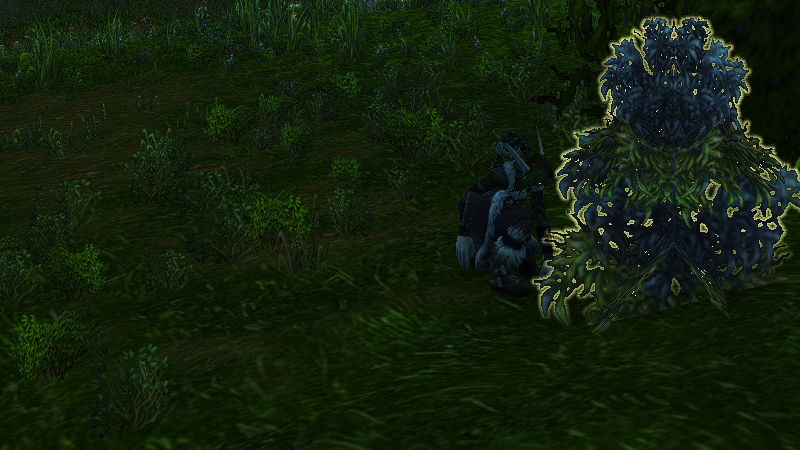
Skill 1-70: The Humble Beginnings
Target Herbs: Peacebloom (Skill 1), Silverleaf (Skill 1), Earthroot (Skill 15).
Prime Hunting Grounds: Any starting zone is suitable, as they are replete with these early herbs.
- Horde: Durotar, Mulgore, Tirisfal Glades.
- Alliance: Elwynn Forest, Teldrassil, Dun Morogh.
Zone-Specific Routes & Wisdom:
A common strategy involves circling Goldshire, then heading east towards Eastvale Logging Camp, north towards the Brackwell Pumpkin Patch, and west back to Goldshire. Peacebloom and Silverleaf are abundant in open fields and under trees. Earthroot typically grows near rocks and cliff bases. The route map from wow-professions.com suggests a loop around the southern part of Elwynn Forest, near Fargodeep Mine and Stonecairn Lake.

Circling Razor Hill, then south towards Sen'jin Village and looping back, is an effective route. The wow-professions.com map depicts a path starting near Orgrimmar, south past Razor Hill towards Sen'jin Village, then looping north along the western mountains.
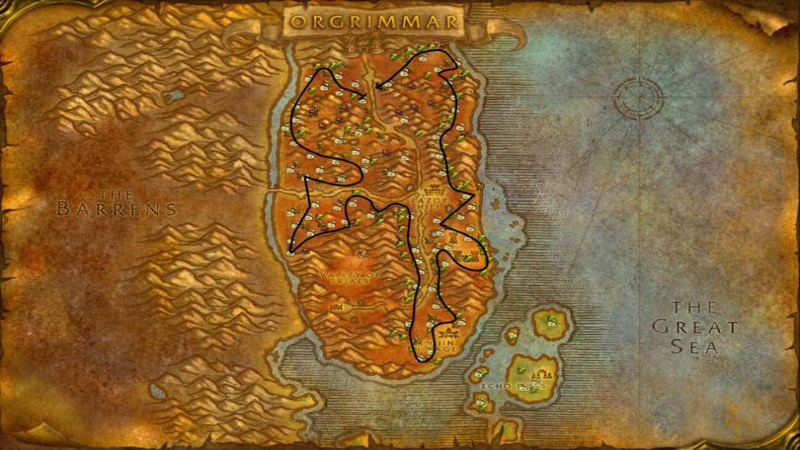
Simply wandering the base of Thunderbluff yields a surprising amount of Peacebloom and Silverleaf. The wow-professions.com map shows a large circuit around this central landmark.
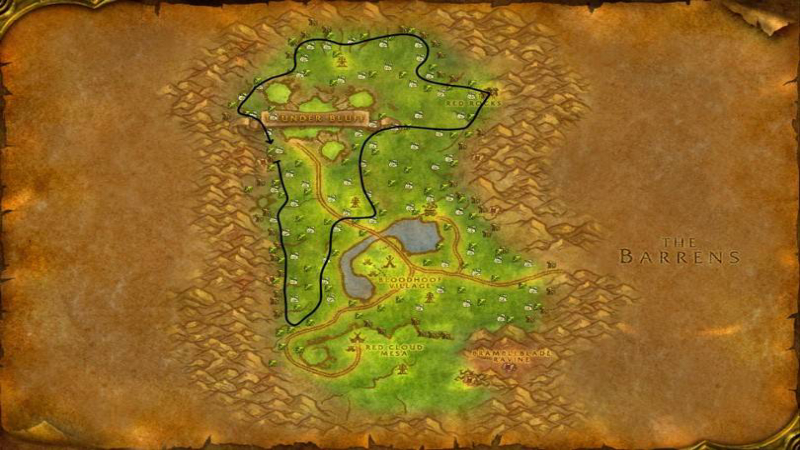
Circuits around Dolanaar, including a southeastern loop around the lake, are recommended.

A suggested path starts at Solliden Farmstead, goes north to the mills, then loops south past Stillwater Pond towards Cold Hearth Manor and Nightmare Vale, before returning. The wow-professions.com map highlights routes in the central and western parts, including areas around Brill.
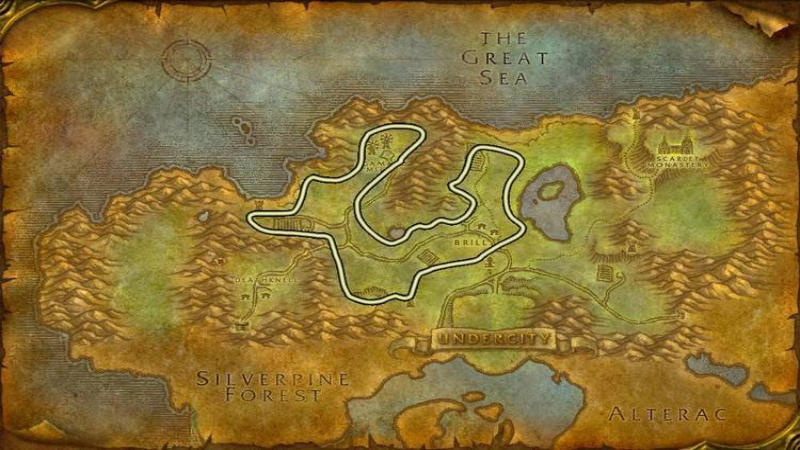
Circling Kharanos towards Brewnall Village and back is effective. Gol'Bolar Quarry is a good spot for Earthroot. The wow-professions.com map focuses on areas around Kharanos and Amberstill Ranch.

Skill 70-115: Journeyman's Path
Target Herbs: Mageroyal (Skill 50), Briarthorn (Skill 70), Stranglekelp (Skill 85 - found underwater).
Prime Hunting Grounds:
- The Barrens (Horde favored): A vast zone, exceptionally rich in Briarthorn and Mageroyal. Its size allows for multiple farming routes, reducing direct competition if players spread out.
- Silverpine Forest (Horde): The southern region, particularly near the Hillsbrad border, is excellent for Briarthorn.
- Loch Modan (Alliance): The eastern side offers good Briarthorn and Mageroyal spawns.
- Darkshore (Alliance): Sweeping from north to south can yield plenty of Briarthorn and Mageroyal.
- Westfall (Alliance): For Mageroyal, a route from the north, south along the coast to Deadmines, then to Sentinel Hill and back up is effective.
Zone-Specific Routes & Wisdom:
A common route for Mageroyal and early Briarthorn starts at Crossroads, heads west towards the Stonetalon Mountains entrance, then north along cliff bases (also good for Earthroot) before the harpy area, then east to the Gold Road and south back to Crossroads. Given Briarthorn's abundance, extending runs to Sludge Fen or doing full zone circuits is viable. Stranglekelp is found along coastlines, such as near Ratchet or the Wailing Caverns subzone.

Concentrate on the southern half, from Pyrewood Village towards the Hillsbrad Foothills entrance. The wow-professions.com map shows a loop in southern Silverpine. Coastal Stranglekelp is also present.
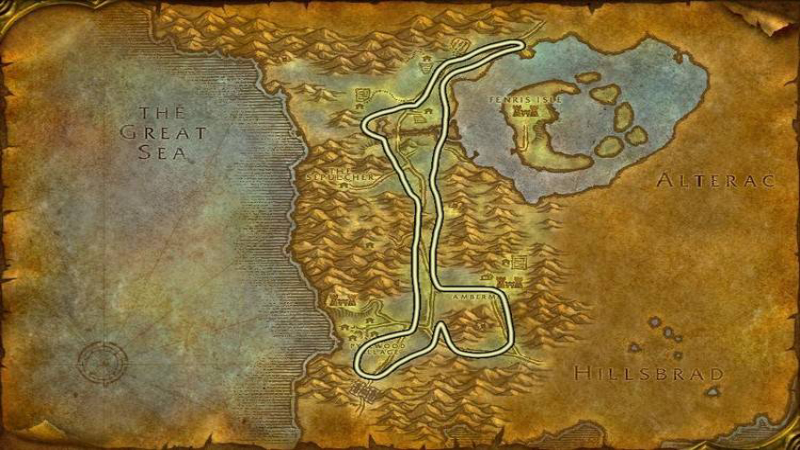
A simple north-south sweep is effective. The wow-professions.com map shows a route along the main road, looping around Twilight Vale. Coastal Stranglekelp is available.

The eastern side of the Loch, near the dam and Thelsamar, is good for Briarthorn. The wow-professions.com map focuses on this area.
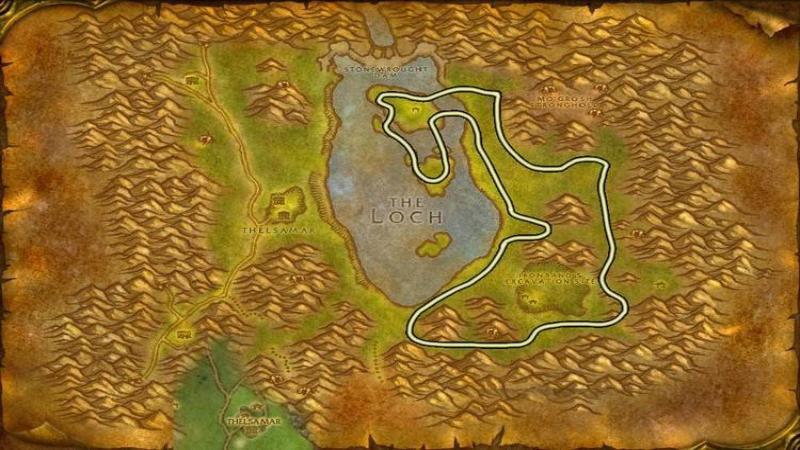
For Mageroyal, a route from the north, south along the coast to Deadmines, then to Sentinel Hill and back up is effective.
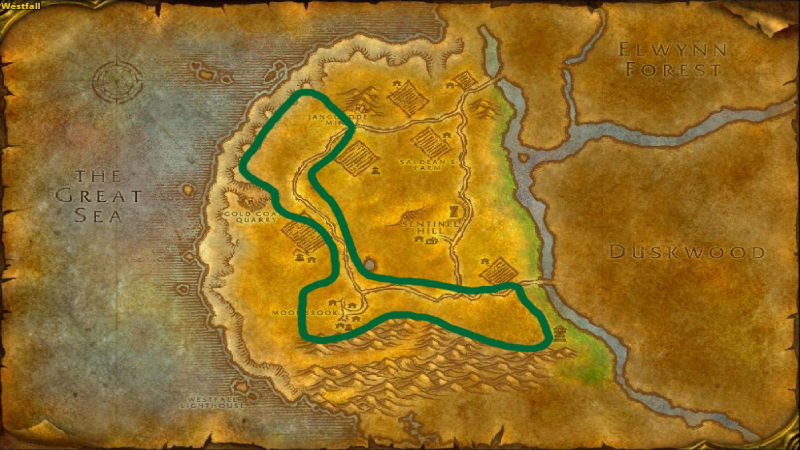
Skill 115-170: Expert's Expedition
Target Herbs: Bruiseweed (Skill 100), Wild Steelbloom (Skill 115), Kingsblood (Skill 125), Liferoot (Skill 150). Stranglekelp (Skill 85) remains relevant near water.
Prime Hunting Grounds:
- Hillsbrad Foothills (Contested, but rich): Excellent for all listed herbs, especially Liferoot near rivers/Azurelode Mine.
- Wetlands (Alliance favored): Good for all herbs, particularly Liferoot near water sources.
- Stonetalon Mountains (Horde favored): Bruiseweed and Wild Steelbloom are common. Kingsblood can be found in The Charred Vale.
- Ashenvale (for Bruiseweed/Kingsblood): Routes around Mystral Lake or west of Astranaar.
Zone-Specific Routes & Wisdom:
The wow-professions.com map details a large loop. For Bruiseweed, circuits from Tarren Mill towards Southshore and around the Yeti cave (Alterac Mountains border for Frozen Herbs) are effective. Kingsblood is often near ruins, and Liferoot near water. The "red lines" on the wow-professions.com map likely indicate higher-level mob areas, so caution is advised until skill 150+ for Liferoot.
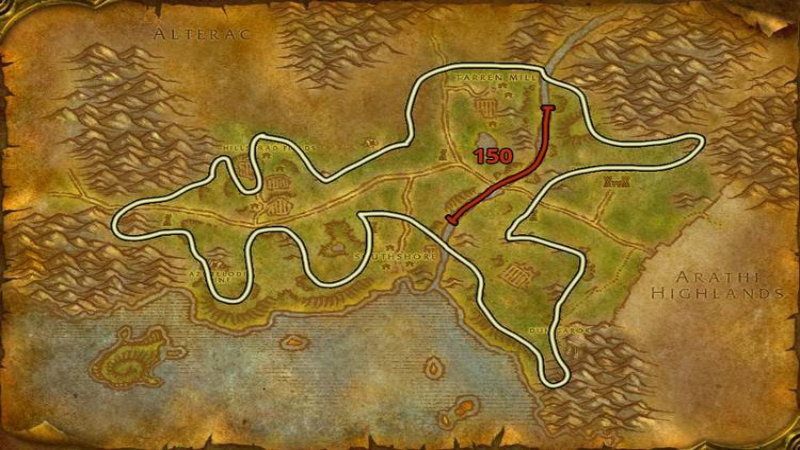
The wow-professions.com map suggests a route along the main road from Dun Algaz, looping south towards Menethil Harbor, then east. Focus on marshy areas for Liferoot. Kingsblood is found near dragonmaw orc areas. Coastal Stranglekelp is abundant.
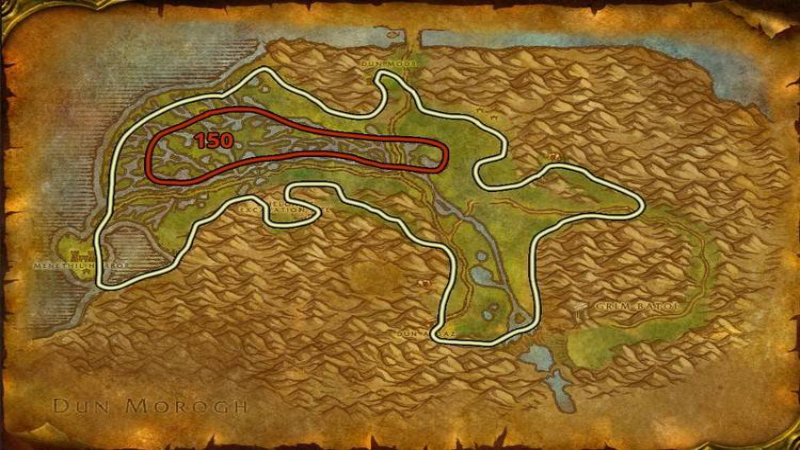
The wow-professions.com map shows a route covering Windshear Crag, Sun Rock Retreat, and Charred Vale. A user-suggested route for Bruiseweed: "Go to Camp Aparaje, head west to the Grimtotem Post, then south to Malaka'jin, then east to the Greatwood Vale". Wild Steelbloom is often near rocky outcrops.
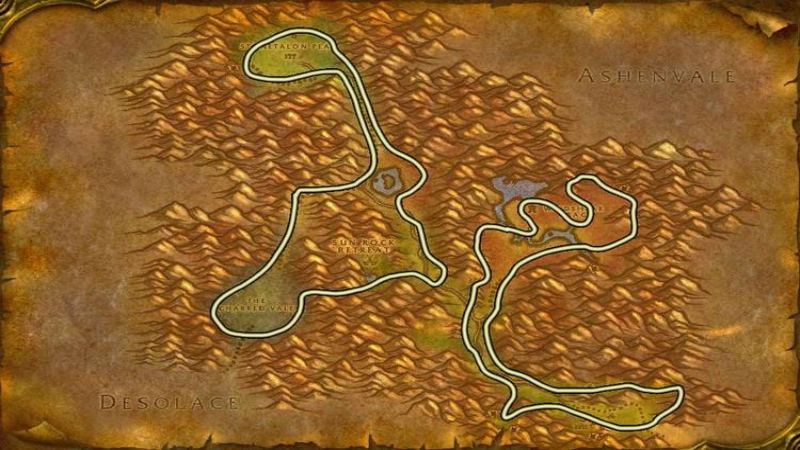
Routes around Mystral Lake or west of Astranaar are effective for Bruiseweed and Kingsblood.
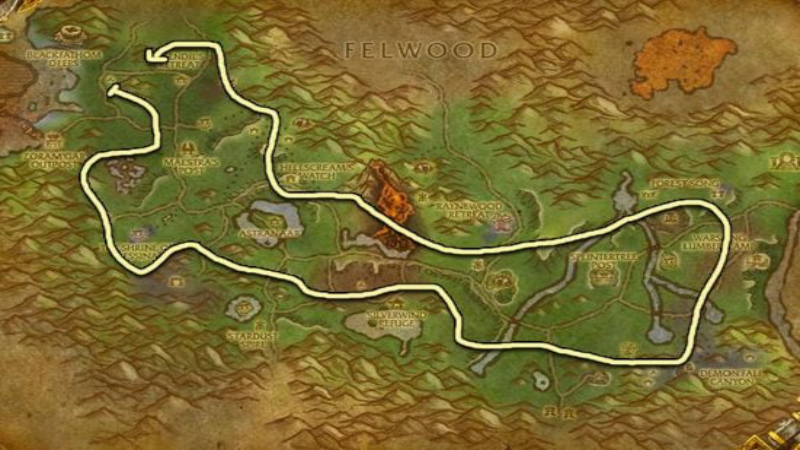
Skill 170-205: Artisan Approaches
Target Herbs: Kingsblood (Skill 125), Liferoot (Skill 150), Fadeleaf (Skill 160), Goldthorn (Skill 170), Khadgar's Whisker (Skill 185).
Prime Hunting Grounds:
- Stranglethorn Vale (The Jungle King): A massive zone, excellent for Goldthorn, Fadeleaf, Kingsblood, Liferoot, and Khadgar's Whisker.
- Arathi Highlands: Great for Goldthorn, Fadeleaf, and Khadgar's Whisker. Also good for Wild Steelbloom if still needed.
- Swamp of Sorrows (for Fadeleaf/Khadgar's Whisker): Full zone circuits are effective.
Zone-Specific Routes & Wisdom:
The wow-professions.com map shows a large loop. Start near Grom'gol Base Camp (Horde) or Rebel Camp (Alliance). Goldthorn favors hillsides and ruins (e.g., troll ruins). Fadeleaf is often in shady spots. Khadgar's Whisker is at tree bases or near ruins. Liferoot is near rivers/coasts. Be prepared for combat due to zone size and mob density.

The wow-professions.com map shows a route circling the outer edges, around Stromgarde Keep and mountains. Goldthorn is on hills. Khadgar's Whisker and Fadeleaf are common around ogre/troll villages. Combining Arathi with The Hinterlands for Goldthorn by using the tunnel between zones allows for continuous farming as herbs respawn.
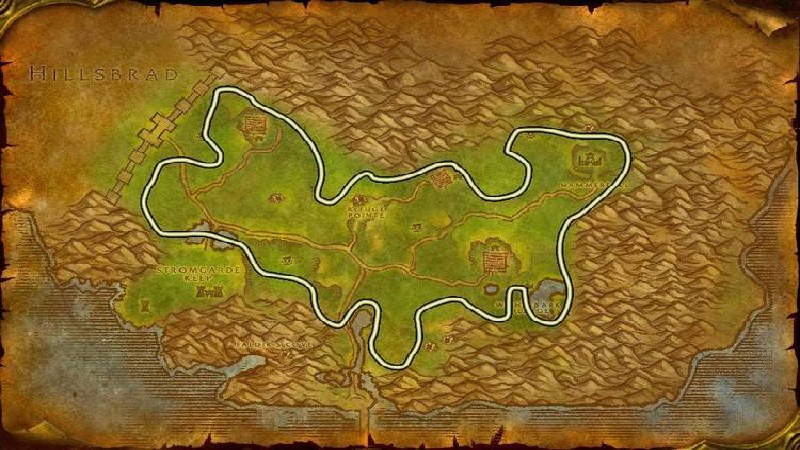
Full zone circuits are effective for Fadeleaf and Khadgar's Whisker gathering.

Skill 205-230: Artisan Begins
Target Herbs: Purple Lotus (Skill 210), Firebloom (Skill 205).
Prime Hunting Grounds:
- Tanaris: Excellent for Firebloom and Purple Lotus, especially around ruins and rock formations.
- Searing Gorge: A prime location for Firebloom due to its volcanic environment.
- Badlands (for Firebloom): Another suitable fiery zone.
- Feralas (for Purple Lotus): Found around the numerous ruins.
Zone-Specific Routes & Wisdom:
The wow-professions.com map shows a route circling the zone's edges, including troll ruins, Steamwheedle Port, and southern dunes. Firebloom clusters near geothermal areas; Purple Lotus near troll ruins and Zul'Farrak. Due to its size, dividing Tanaris into sections or using a zig-zag pattern is advisable.

A more compact zone for easier circuits. The wow-professions.com map shows a loop around The Cauldron. Full zone circles are recommended for Firebloom.
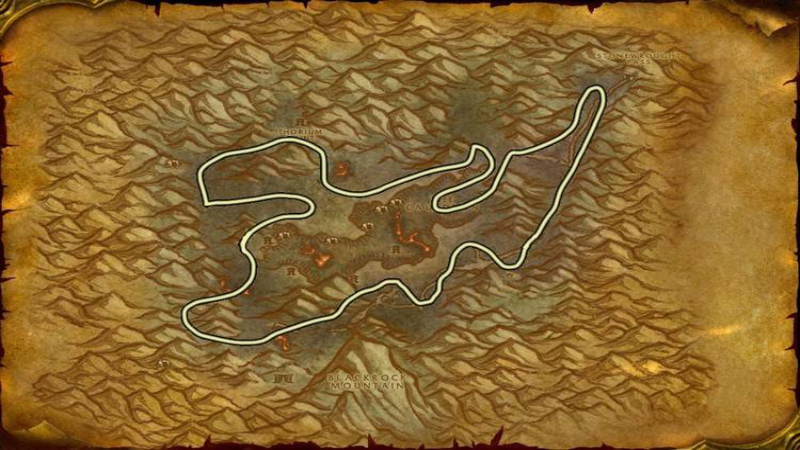
GoldGoblin suggests a Sungrass route in northern Feralas, or a larger loop including the south. Purple Lotus is found around the numerous ruins.
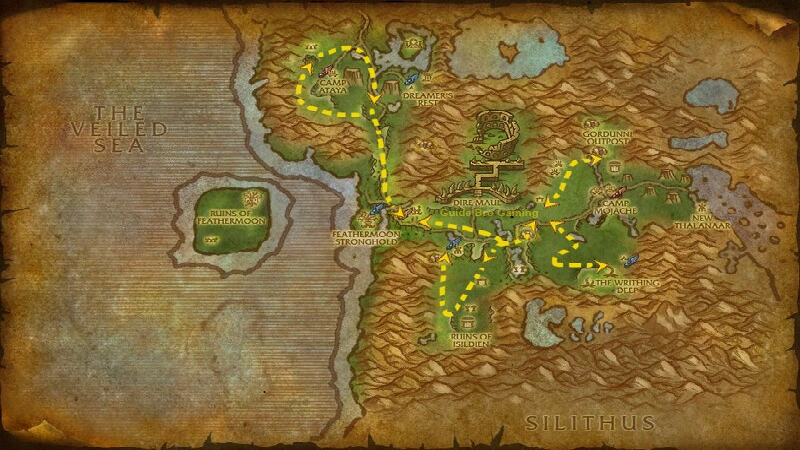
Skill 230-270: The Home Stretch
Target Herbs: Sungrass (Skill 230), Purple Lotus (Skill 210), Ghost Mushroom (Skill 245 - CAVES!), Golden Sansam (Skill 260).
Prime Hunting Grounds:
- The Hinterlands (The Sweet Spot): Fantastic for Sungrass. Also has Purple Lotus, Golden Sansam, and the renowned Ghost Mushroom caves.
- Feralas (for Sungrass/Purple Lotus): Especially northern parts, or the full zone if time permits.
- Azshara (for Sungrass): Offers a good density of nodes.
Zone-Specific Routes & Wisdom:
The wow-professions.com map shows a route covering most of the zone, with an "X" marking a Ghost Mushroom cave. Sungrass is abundant in open fields. Golden Sansam and Purple Lotus are often near troll ruins like Jintha'Alor or Quel'Danil Lodge.
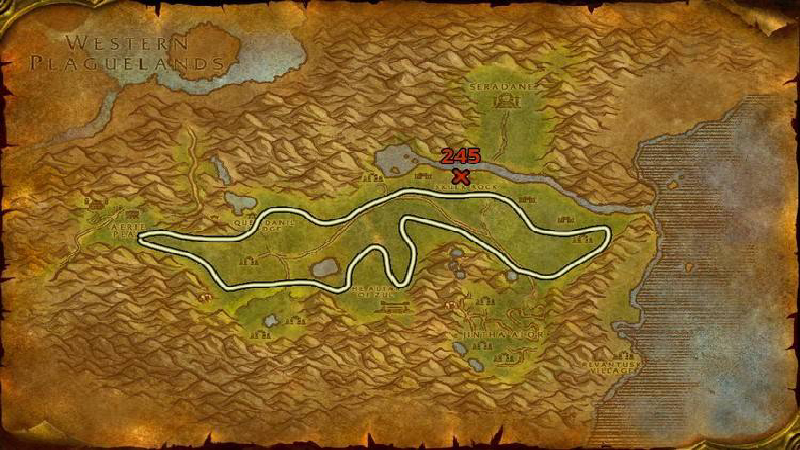
Offers a good density of nodes for Sungrass gathering. Known for the highest herb node density.
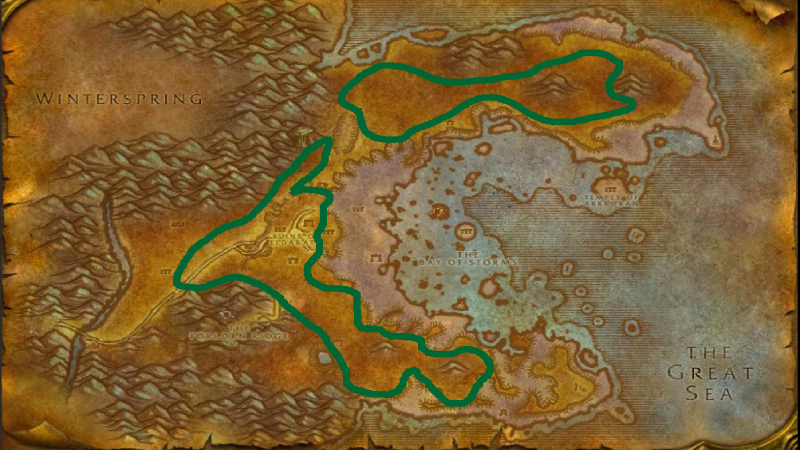
Skill 270-300: Master of the Craft
Target Herbs: Sungrass (Skill 230), Gromsblood (Skill 250), Golden Sansam (Skill 260), Dreamfoil (Skill 270), Mountain Silversage (Skill 280), Plaguebloom (Skill 285).
Prime Hunting Grounds:
- Felwood (The Corrupted Paradise): The premier zone for this final stretch, packed with all listed high-level herbs.
- Western Plaguelands & Eastern Plaguelands (for Plaguebloom, Dreamfoil, Mountain Silversage): High-level zones suitable for late-stage herbs. EPL is also a Black Lotus zone.
- Azshara (for Dreamfoil, Golden Sansam, Mountain Silversage): Noted for high herb node density.
- Un'goro Crater (for Dreamfoil, Golden Sansam, Mountain Silversage): Another solid option.
Zone-Specific Routes & Wisdom:
The wow-professions.com map shows a zig-zagging route covering most of the zone. Gromsblood is often in corrupted areas. Dreamfoil, Golden Sansam, and Mountain Silversage are more widespread. Plaguebloom tends to be in northern, blighted parts. Zig-zag patterns or full circles are recommended. Felwood is considered excellent for Gromsblood, and also yields Golden Sansam, Dreamfoil, and Purple Lotus, making it ideal for Alchemists.
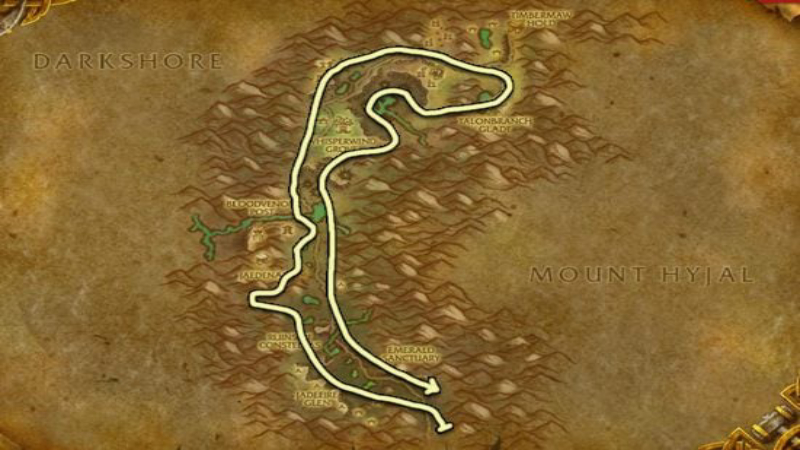
Routes typically cover Tyr's Hand, Corin's Crossing, and riverbanks. Plaguebloom is common. This is also a Black Lotus zone, so expect competition.

Good for Plaguebloom, Dreamfoil, and Mountain Silversage farming.
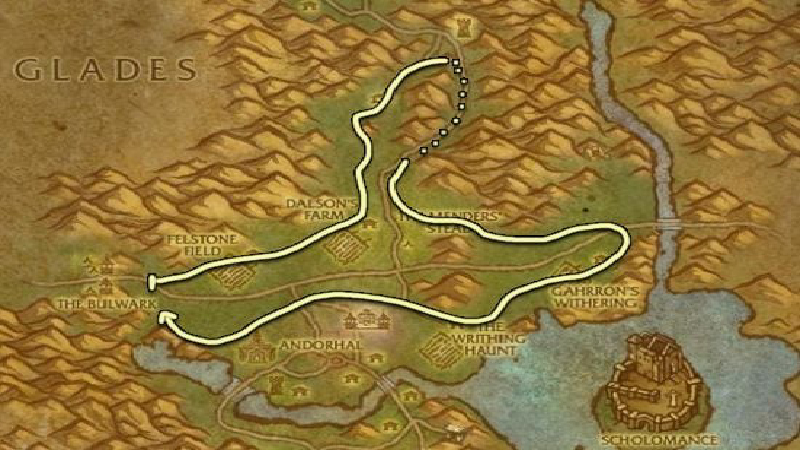
Another solid option for Dreamfoil, Golden Sansam, and Mountain Silversage.
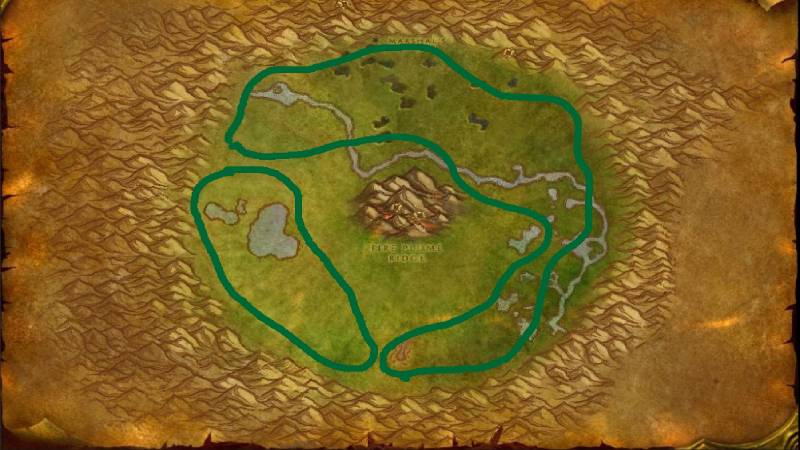
| Skill Range | Target Herbs (Skill Req.) | Primary Zone(s) | Key Tips/Secrets |
|---|---|---|---|
| 270-300 | Sungrass (230), Gromsblood (250), Golden Sansam (260), Dreamfoil (270), Mountain Silversage (280), Plaguebloom (285) | Felwood (Best), WPL, EPL, Azshara, Un'Goro Crater | Felwood is king for variety and density. EPL/WPL good for Plaguebloom/Dreamfoil/Silversage but also Black Lotus competition in EPL. Azshara has high node density. |
Beyond the Beaten Path: Advanced Herbalism & Rare Finds
Venturing off the main leveling paths reveals herbs of exceptional value and utility, often requiring specific farming strategies or knowledge of unique spawn locations.
The "Must-Have" Herbs & Where to Snag Them:
Swiftthistle: The Alchemist's and Rogue's Friend
This valuable herb is not picked directly but is a secondary find from Mageroyal and Briarthorn nodes.
- Value Proposition: Essential for Swiftness Potions (favored by flag carriers and for quick escapes) and Thistle Tea for Rogues.
- Best Zones (for parent herbs): The Barrens, Darkshore, Silverpine Forest, Loch Modan (as per the 70-115 skill bracket).
Ghost Mushrooms: Spelunking for Profit!
These fungi are found exclusively in caves and require Herbalism skill 245.
Value Proposition: Used in powerful potions such as Elixir of Shadow Power and the highly valued Limited Invulnerability Potions.
Farming Tip: For Hinterlands caves, one strategy is to position a character inside and check for respawns every 15-20 minutes. For Maraudon, learning a stealth route or an efficient clear path is beneficial. The ability to farm these in instances like Maraudon allows players to bypass open-world competition and manage respawns through instance resets (up to five per hour).
Wildvine: The Elusive Creeper
A rare material that can sometimes be obtained when gathering Purple Lotus nodes. It also drops from Troll mobs, notably in Stranglethorn Vale and The Hinterlands.
- Value Proposition: Used in various crafting recipes, including some for Leatherworking (e.g., Wild Leather set) and Tailoring (e.g., Dreamweave items).
- Farming Strategy: When herbing, focus on Purple Lotus in Felwood (which has 5 ruin locations where Purple Lotus grows) or Azshara. For mob farming, target troll camps in Stranglethorn Vale or The Hinterlands. Jintha'Alor (elite trolls) is another potential spot. One source claims 10-20 Wildvine per hour from STV trolls with a group, noting high sale prices, while another suggests a low drop rate from Purple Lotus (1 per 1-2 stacks). The dual-source nature and overall low drop rate contribute to its scarcity and value.
Black Lotus: The Holy Grail of Herbs!
The rarest and most valuable herb in Classic WoW, requiring skill 300 to gather.
Spawn Mechanics & Timers:
- Historically, only one Black Lotus would spawn per zone at any given time.
- The respawn timer is approximately one hour. Some reports suggest hotfixes may have reduced this to as low as 10 minutes, with up to 30 potential spawn nodes per zone.
- A 2020 hotfix mentioned that Black Lotus spawns more often, in new locations, and has a chance to be obtained from other high-level herbs (like Gromsblood, Golden Sansam) if the herbalist has 300 skill.
- Dead players cannot see Black Lotus nodes unless their Herbalism skill is 300 or higher.
Farming Routes & Tips:
Can be quieter after the initial leveling rush and is a good option in later phases. Avoid the southern elite area.
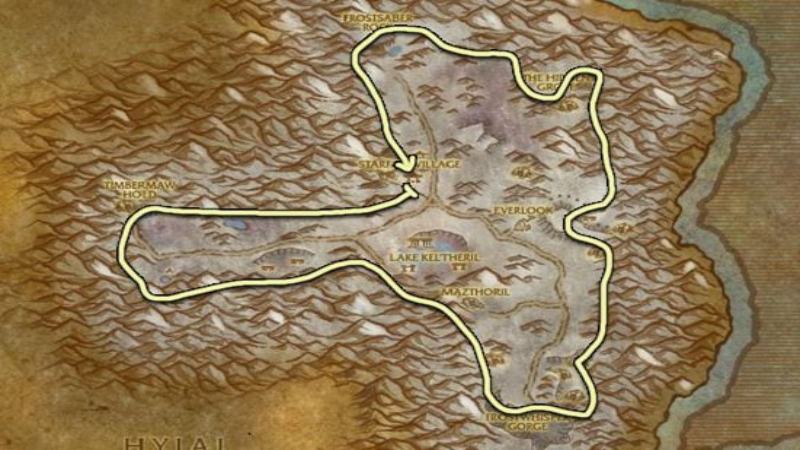
A longer farming route, potentially less crowded during Phases 3-5. Becomes extremely busy in Phase 6 (Naxxramas).
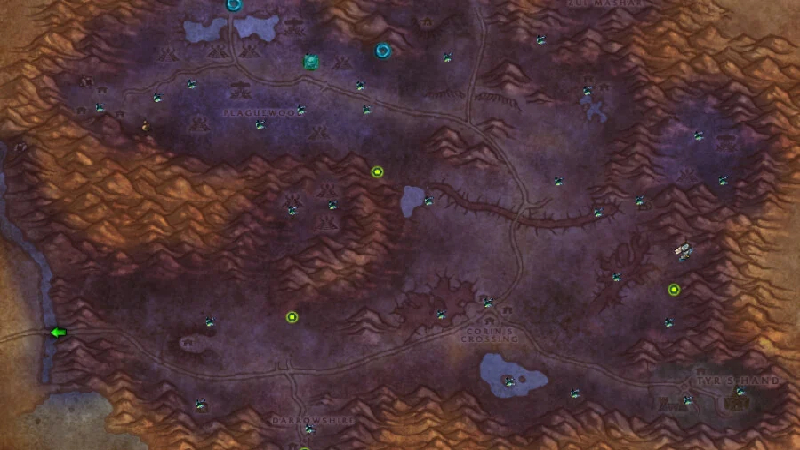
Considered the easiest zone to farm but often the most contested due to proximity to Molten Core and Blackwing Lair. A specific spot known as "The Quads" (coordinates 28,62 at Draco'dar) allows visibility of four potential spawn points.
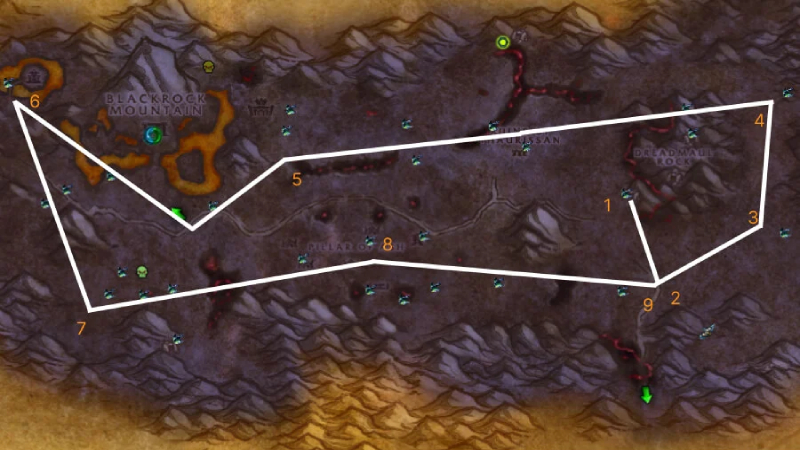
Viable before Phase 5 (AQ release); highly contested afterward. Hive caverns with elites should generally be avoided unless in a group.
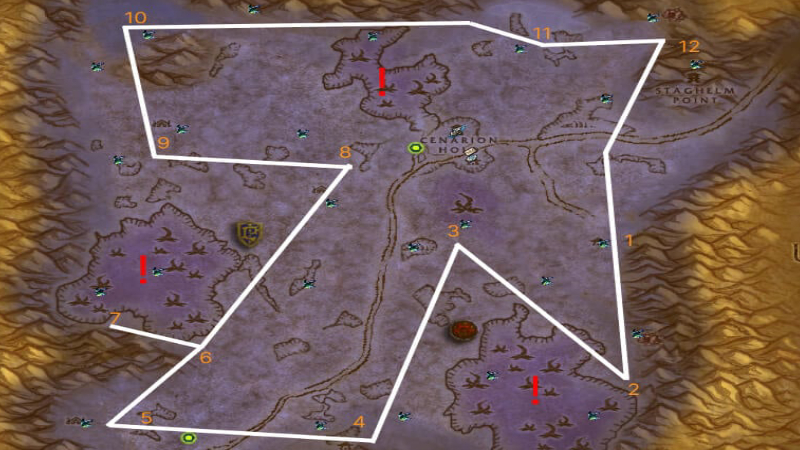
- Knowledge of all potential spawn locations is critical; Gathermate2 is invaluable
- Silithus: Viable before Phase 5 (AQ release); avoid hive caverns unless grouped
- Winterspring: Can be quieter after initial leveling rush, good in later phases
- Eastern Plaguelands: Longer route but potentially less crowded during Phases 3-5
- Expect intense competition from bots and organized farming groups
- Burning Steppes: Most contested due to proximity to raids
- "The Quads" spot allows visibility of four spawn points but is heavily camped
- EPL becomes extremely busy in Phase 6 (Naxxramas)
Value Proposition: A key ingredient for powerful end-game flasks such as Flask of Supreme Power, Flask of the Titans, and Flask of Distilled Wisdom. The extreme rarity and high demand for these flasks drive the Black Lotus's legendary status and price.
Dungeon Crawling for Botanists: Instance Herbing
Instances offer a controlled environment for herb gathering, free from open-world competition and PvP. The ability to reset instances (up to five times per hour) allows for predictable farming.
Scarlet Monastery (SM):
- Graveyard: Known for Grave Moss (Skill 120) and Kingsblood (Skill 125). Reports suggest about 3 spawns that can be either Grave Moss or Kingsblood.
- Library & Armory: Each has one Fadeleaf spawn near the beginning.
- Cathedral: Contains two guaranteed Goldthorn nodes.
Herbs in SM instances typically respawn after about 20 minutes, or the instance can be reset.
Maraudon:
As previously noted, excellent for Ghost Mushrooms (Skill 245) and Blindweed (Skill 235).
Stealth Runs: Rogues and Druids can perform stealth runs, focusing solely on herb collection. Warlocks also have effective solo farming strategies. A video guide for a Shaman farming Ghost Mushrooms claims a yield of about 30 per hour through instance resets.
Dire Maul East (DM:E):
Rich in high-level herbs: Dreamfoil, Gromsblood, Ghost Mushrooms, and Golden Sansam.
Farming Strategies: Various strategies exist, including "Jump Runs" or "Lasher Farming," which involve clearing specific trash packs (lashers can drop herbs) or bosses to access herb nodes and Rich Thorium Veins. Warlocks have documented solo strategies. One herbalist reported that logging out for 5 minutes after an herb run and then re-entering is an effective method. A video guide for a quick herb run shows a yield of 4 Gromsblood and 2 Dreamfoil, with an estimated income of 60 gold per hour.
Zul'Gurub (ZG - Raid):
Bloodvine (Skill 300) is unique to this 20-man raid instance. It is a crucial component for crafting items like the Bloodvine Lens and Goggles, which are highly valuable for certain classes. Rogues can perform stealth runs within ZG to gather Bloodvine.
Turning Petals into Piles of Gold: Gold-Making Secrets
Successfully leveling Herbalism is only half the journey; the other half is transforming those gathered plants into tangible wealth.
The Million-Gold Question: Save or Sell?
Deciding whether to sell herbs directly or save them for personal use (or for an Alchemy alt) is a constant consideration for herbalists.
Herbs for Alchemists:
Alchemists are primary consumers of herbs, using them to level their skill and craft essential raid consumables.
- Early Game (Peacebloom, Silverleaf, Earthroot): These are mainly used for leveling potions and may not yield high profits individually, but they are necessary for alchemists starting out. Selling them as "Alchemy leveling kits" can be a viable strategy.
- Mid Game (Mageroyal, Briarthorn, Stranglekelp, Bruiseweed, Kingsblood, Liferoot): Briarthorn (due to its chance to yield Swiftthistle) and Stranglekelp are consistently in demand. Kingsblood and Liferoot are used in many useful potions. However, some find the Bruiseweed-Liferoot-Kingsblood tier less profitable, suggesting selling these raw or using them for personal potion crafting.
- Late Game (Fadeleaf, Goldthorn, Khadgar's Whisker, Firebloom, Sungrass, Gromsblood, Dreamfoil, Mountain Silversage, Plaguebloom, Ghost Mushroom): This is where significant gold can be made. These herbs are essential for raid potions, flasks, and high-end elixirs.
Cash Crops: Herbs that Sell Well Directly:
- Black Lotus: The undisputed king, commands exceptionally high prices.
- Dreamfoil, Gromsblood, Mountain Silversage, Plaguebloom: Consistently high demand due to raiding needs.
- Ghost Mushrooms: Valued for their rarity and use in LIPs.
- Swiftthistle: Always popular for PvP and speed enhancements.
- Stranglekelp: Required for many mid-level potions and can be tedious to farm, maintaining its value.
- Wildvine: If acquired, these can sell for a significant profit.
Playing the Auction House (Lightly):
- Timing Sales: Listing raid-related consumables and herbs leading up to typical raid nights (often Tuesday, Wednesday, or Thursday evenings) can capitalize on peak demand. General-purpose herbs often sell well on weekends when player activity is higher.
- Stack Sizes: Experiment with different stack sizes. While full stacks of 20 are common for high-volume herbs, smaller stacks might sell faster or for a higher per-unit price for certain items.
- Undercutting: Modest undercutting is a common practice, but significantly depressing prices harms the market for all sellers.
- Vendor Price Awareness: Always compare the current Auction House price to an herb's vendor sale price plus the auction deposit. If the AH price is lower, vendoring the item is more profitable. Addons like VendorPrice can assist with this. Strategic selling, understanding peak demand times, and using Auction House tools can significantly enhance profitability.
Bonus Gold & Rep: Morrowgrain Research
For Alliance players seeking Darnassus reputation (often for the Nightsaber mount), the Morrowgrain Research quest line offers an alternative avenue. Morrowgrain is cultivated by using an Evergreen Pouch (obtained from Mathrengyl Bearwalker in Darnassus) with Tharlendris Seeds and Un'Goro Soil samples. Each turn-in of 10 Morrowgrain yields 250 Darnassus reputation and a [Cenarion Circle Cache], which can contain valuable potions (like Frost Oil or Shadow Power Elixirs) or herbs. Some players report that this activity can be close to break-even or even slightly profitable from the cache contents, in addition to providing experience points and reputation.
| Herb Name | Key Use(s) | Primary Farming Zone(s) / Method | Value Tier |
|---|---|---|---|
| Black Lotus | Flasks (Titans, Supreme Power, Distilled Wisdom) | Winterspring, EPL, Burning Steppes, Silithus (Highly Contested) | Legendary |
| Dreamfoil | Major Mana Potions, Greater Protection Potions, Flasks | Felwood, Azshara, EPL, WPL, Un'Goro, DM:E | High |
| Gromsblood | Mighty Rage Potion, Flask of the Titans, Elixir of Giants | Felwood (Best), Blasted Lands, Desolace, DM:E | High |
| Mountain Silversage | Major Healing Potion, Elixir of Mongoose, Flask of Supreme Power | Winterspring, EPL, Azshara, WPL, Burning Steppes, Silithus, Un'Goro | High |
| Plaguebloom | Major Healing Potions, other high-level consumables | EPL, WPL, Felwood | High |
| Ghost Mushroom | Limited Invulnerability Potion, Elixir of Shadow Power | Hinterlands (Caves), Maraudon (Instance), DM:E (Instance) | High |
| Swiftthistle | Swiftness Potion, Thistle Tea (Rogue) | From Mageroyal/Briarthorn (Barrens, Darkshore, etc.) | Mid-High |
| Goldthorn | Magic Resistance Potion, Frost Oil, Elixir of Fortitude | Arathi Highlands, Stranglethorn Vale, Hinterlands | Mid |
| Stranglekelp | Various mid-level potions (e.g., Free Action Potion, Mana Potions) | Coastal areas (Barrens, Silverpine, Wetlands, etc.) | Mid |
| Wildvine | Leatherworking/Tailoring recipes (e.g., Wild Leather set, Dreamweave) | From Purple Lotus nodes (Felwood, Azshara) or Troll mobs (STV, Hint.) | Mid-High (Rare) |
Outsmarting the Crowd: Tips for Competitive Herb Gathering
Success in Herbalism, especially on populated servers, often requires more than just knowing routes; it demands adaptability and an understanding of game mechanics.
Navigating Packed Zones & Beating the Competition (Ethically!):
- Farm Off-Peak Hours: Gathering during early mornings or late nights typically means fewer competitors and thus more available herbs.
- Explore Less Popular Spots: While guides often highlight hotspots, sometimes slightly less optimal zones offer better yields due to reduced competition. For example, Azshara has a high herb density but lacks Black Lotus, potentially attracting fewer high-level farmers focused on that specific herb.
- Layer Hopping (Use With Caution & Adhere to Server Rules): If server layering is active and its use for resource gathering is permitted, switching layers can sometimes reveal fresh herb nodes. However, this practice can be viewed as exploitative by some community members.
- Instance Farming: As detailed earlier, dungeons like Maraudon, Scarlet Monastery, and Dire Maul East serve as personal herb gardens, free from open-world competition.
- Efficiency is Paramount: Utilizing a faster mount, having well-planned routes, and minimizing downtime between nodes are crucial for maximizing herbs per hour.
The "Node Slot" Theory: One plausible theory suggests that zones have a finite number of potential "slots" for herb nodes and a target number of concurrently active nodes. Picking an herb frees up a slot, and the game system attempts to fill it, possibly with a different herb type if multiple types share common spawn points.
The Importance of Clearing Nodes: Selectively picking only high-value herbs and leaving lower-value ones might inadvertently prevent new, potentially more valuable herbs from spawning in those occupied slots. Clearing most nodes along a route can help the zone's herb population refresh more effectively.
Black Lotus Exception: Black Lotus follows its own unique and much rarer spawn mechanics, historically limited to one per zone at specific points, although hotfixes may have altered this to include a chance to proc from other high-level herbs for skilled herbalists.
Classy Gathering: Leveraging Your Character's Strengths:
Certain classes possess abilities that provide significant advantages in Herbalism, impacting efficiency and access to nodes.
Often considered premier gatherers. Instant-cast Travel Form dramatically reduces travel time between nodes. There is debate whether Druids could herb while shapeshifted in original Vanilla WoW. Abilities like Hibernate can neutralize beast-type mobs guarding nodes. Tauren Druids also benefit from a +15 racial skill bonus to Herbalism.
Stealth allows access to herb nodes guarded by hostile mobs without engaging in combat, saving time and resources. This is particularly useful for high-risk, high-reward nodes.
A Hunter's pet can be commanded to engage and tank mobs, allowing the Hunter to quickly gather a nearby herb.
The Polymorph ability can temporarily neutralize a humanoid or beast mob guarding an herb node.
Good Karma Gathering: Sharing is Caring (Sometimes!):
In a shared online world, an informal player-driven etiquette often develops around resource gathering.
- The Contested Node Dance: If another player is actively fighting a mob next to an herb node, it is generally considered good manners to allow them to gather it once they are out of combat. Offering assistance in killing the mob is a friendly gesture.
- Racing for Nodes: Using speed-enhancing abilities to intercept a node that another player is clearly moving towards is often perceived as rude.
- Skill-Up Sharing in Parties: If an herb node is orange or yellow for multiple herbalists in the same party, they can often all receive a skill-up if they gather from the same node in quick succession before it despawns.
"The strongest herbalist is not the one who gathers the most, but the one who knows when to share."
Go Forth and Gather!
Adventurers are now equipped with a comprehensive understanding of Herbalism in Classic WoW, from the initial steps of finding a trainer to the advanced strategies for farming the rarest and most valuable flora Azeroth has to offer. The journey from skill 1 to 300 is one that traverses sun-drenched fields, murky swamps, treacherous mountains, and corrupted forests.
Mastering Herbalism is more than just a means to an end; it's an exploration of the world, a test of patience, and a rewarding endeavor that can significantly contribute to an adventurer's wealth and their guild's success. By applying the knowledge of optimal routes, understanding herb spawn mechanics, leveraging class advantages, and navigating the social dynamics of a shared world, any dedicated herbalist can thrive. The path is clear: keep "Find Herbs" active, bags ready, and spirits high. May all herbalists find their routes bountiful and their competition scarce. Happy herbing!
